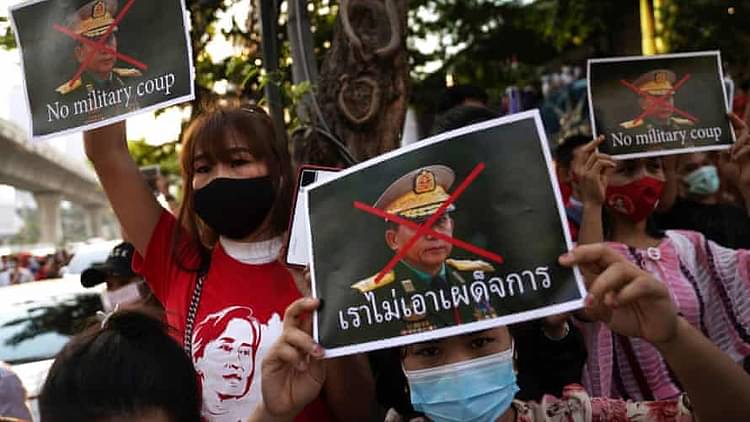The Myanmar army staged a coup d’etat and seized power on February 1 and declared a state of emergency for one year. The army dismissed the government of the National League for Democracy (NLD) which was returned to power for the third time in a row after the general elections of November 8, 2020.
The excuse for the coup was that the army believed the elections had been “rigged” by the NLD. No evidence was produced. When you do a grossly unconstitutional and illegal act, no evidence is necessary to justify it. Following the coup all top leaders of the NLD were arrested, including Aung San Suu Kyi, chairman of the party and the State Counsellor of the country – a position analogous to that of a prime minister.
The army had ruled Myanmar with an iron hand for nearly half a century from 1962 to 2011. It was in 2011 that the first elections were held and the NLD came to power. During the first fifty years of army rule there was hardly any resistance. People meekly accepted the rule of the brass hats.
But ten years ago when they tasted democracy for the first time in half a century, everything changed. Resistance to military dictatorship developed all over the country. Since then the army has been trying to suppress protests by the liberal use of the bullet and the bayonet.
So far, the army has shot dead more than two hundred people and injured many more. But defiance to army rule continues. Bullets have failed to suppress them. In town after town in Myanmar angry people have come out on the streets by the hundreds, carrying posters decrying the rule by the junta and demanding immediate restoration of democracy.
There have been pathetic reports of two nuns in a northern Myanmar city offering themselves to be shot by the army, in exchange for the lives of the children they had held. They pleaded with the army not to torture and shoot the children but to shoot and kill them instead.
While the whole world condemned the extinction of democracy in Myanmar, China’s was a tongue-in-cheek response. Initially it dismissed the coup as an internal matter of Myanmar. The Western world thought that what the Myanmar army did had the backing of China.
Things became clearer when the Security Council of the United Nations met immediately after the coup to issue a joint statement condemning the coup. This could not be done as China, as a permanent member of the UNSC, vetoed the proposal, confirming the suspicion that China was behind the Myanmar army.
India has refrained from commenting on the coup but New Delhi is keenly watching the developments in Myanmar. If China did have a hand behind the coup, India has reasons to worry. China had long been interested in building a high speed railway line from Kunming to Muse, the capital of Mu Se Township in the northern Shan State in Myanmar, situated on the Shwell river and connected by a road and bridge to Ruilli in the Yunan Province of China. This will be the first phase.
In the second and final phase, the line will be extended from Muse to Mandalay and then on to Kyaukphyu port in the Rakhine province in western Myanmar. The port is on the coast of Bay of Bengal.
There was a strong opposition to the project by the people of Myanmar as the project will involve cutting down of trees over a wide region through which the railway line will pass. It will cause deforestation which, in turn, will have a negative impact on the ecology of the areas affected. In face of stiff public opposition, work on the project could not start but it was never formally abandoned.
The Chinese have all along been saying that the project will be taken up and completed. Now, with the army in power, the situation is propitious for China to ignore public opposition and steamroll the railway project, posing a strategic threat to India.
Where does the strategic threat lie? China has already had direct access to the Arabian Sea on the western flank of India through Pakistan (and also through Pak-occupied part of Kashmir). It has taken over the Gwadar sea port from Pakistan and is reportedly planning to build a naval base in the port.
Now, if the proposed railway line up to Kyaukphyu becomes a reality, it will mean that China will have a direct access also to the Bay of Bengal on the eastern flank of India through Myanmar. India’s eastern naval fleet is headquartered at Vishakhapatnam on the Bay of Bengal. India’s only tri-services command of army, navy and air force is in the Andaman and Nicobar Islands with headquarters at Port Blair. Both will come under constant Chinese surveillance.
China has already taken over the Hambantota seaport on the southern tip of Sri Lanka in the Bay of Bengal. Sri Lanka failed to pay the debt (construction cost of $361 million and interest thereon) that it owed to a Chinese government enterprise. Under heavy Chinese pressure, Sri Lanka had to hand over the port and about fifteen thousand acres of land around it to China for 99 years.
Thus China gained a strategic foothold in the Indian Ocean Region (IOR). India saw everything happening before its eyes but could do nothing to prevent it as the Sri Lankan government at that time had a marked pro-China tilt. If the Kunming-Kyaukphyu railway line is built, it will add to India’s security concern. (IPA Service)
































